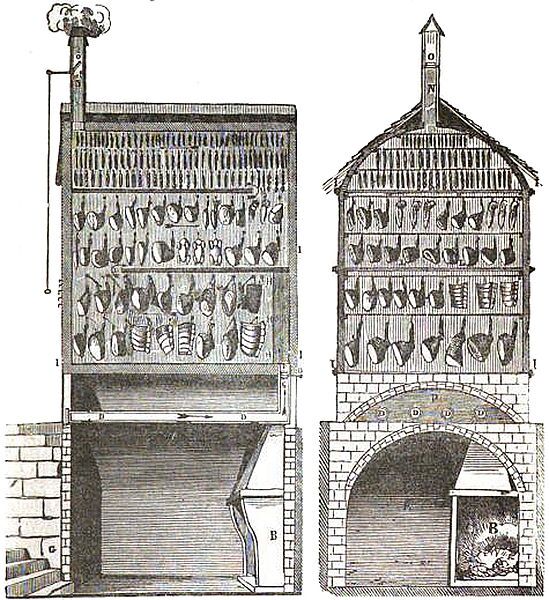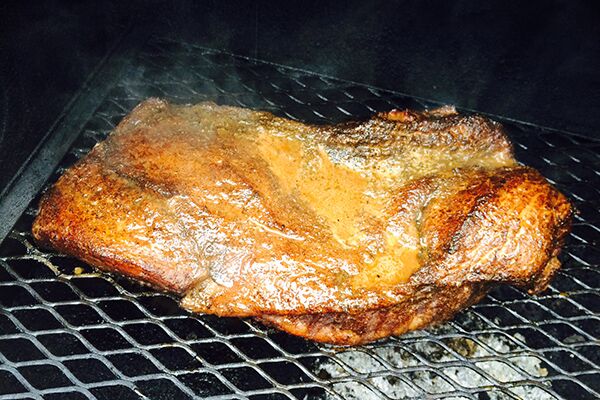Please enjoy this encore post on fantasy kitchens and real-life barbecue, originally published January 2016.
In this ongoing series, we ask SF/F authors to describe a specialty in their lives that has nothing (or very little) to do with writing. Join us as we discover what draws authors to their various hobbies, how they fit into their daily lives, and how and they inform the author’s literary identity!
When I was a kid reading fantasy fiction, the second the story got to a forge or an inn or a kitchen, I slowed down and read closely.
To my 12-year-old head, such gathering points of classic fantasy fiction were places where you saw people conduct the business that would sustain the needs of their everyday lives. This business was often primitive but ingenious: you got to glimpse how they prepped skins for carrying water, put their boots together, mended weapons, and preserved their food. You learned how everyday people did the most with the least.
I often had fantasies of trying to build my own forge and make my own arrowheads, but those fantasies never came true. Being alive is a lot easier in the modern era than it was in the Middle Ages, so it’s almost something of a luxury to devote time to learning these old processes.
But one old process has been getting a lot of attention lately: smoking meat. Specifically, Texas-style barbecue, which has become so feverishly popular that it’s sent brisket prices soaring (and then plummeting again). What was originally a working-person’s necessity is now a luxury good, a delicacy.
Living in Texas, I am especially susceptible to the allure of smoked meat. But part of the allure is the same allure of the old forge or inn in a fantasy story: it is a messy, dirty, primitive act, one that was originally more about the preservation of food than it was about delicious, tender meat.
Originally, smoked meat was about two things: dehydrating it (think beef jerky) and working wood smoke into the meat, as smoke contains chemicals that are antibacterial. In the Southern barbecue tradition, though, we don’t smoke for dehydration much. Rather, Southern barbecue focused on a big, cheap, undesirable cut of meat—like a brisket or a pork shoulder—and cooking it for a long, long, long time until it became tender. Then your whole family would live off of the proceeds for days.

This has evolved into its own regional cuisine, focused on taste and texture more than producing a large quantity of cheap meat that keeps. And this is what I usually make.
I do it because it’s delicious, sure. I also do it because my family and friends ask me on a regular basis to do it for them—for parties or gatherings. It’s sort of the one trick I can offer them, as home or car repair is out of the question.
But a big part of why I do it is that it’s just fun to wake up before dawn on a cold winter morning, go out to the smoker, carefully create a hot bed of coals, and then carefully feed cured wood into it, controlling the flow of air to the firebox in order to control the temperature in the main smoke chamber. Then once the meat’s on you hang out and tend to this fire for up to 14 hours, doing your utmost to keep it burning at the right rate.
It is a primeval, dirty, laborious act, one borne from a time when people had few resources but lots of time—in stark contrast to today, when we have lots of resources but little time. For that reason alone, I enjoy it.
There’s more to it than the fire, of course. I’ll focus on brisket, since that’s everyone’s current fave.
Prepping a brisket is another thing a household never has to do anymore: we no longer have to deal with a giant, big, ungainly hunk of meat, weighing up to 20 pounds. But you do when you smoke brisket. I’ve worked on my routine here, and you’ve got to trim a great deal of fat off of the brisket, mostly off the top and the bottom.
A lot of people think the reason brisket is so juicy is the fat cap on the top—but there’s actually a ribbon of fat running through the interior, and that’s where all the juice comes from. The fat cap on the top mostly gets cut off when your guests eat a slice of the brisket—but that removes a great deal of the “bark,” the accretion of smoke and juice that hardens along the exterior of the brisket, which is a great deal of what makes brisket good to eat.
So, you’ve got to trim the hell out of this thing. I usually pop the brisket out of the coldest part of the fridge and use a giant knife to cut away the layers of fat. I save these trimmings to later make stocks and broth for stuff like ramen and French onion soup (the production of stock is another Primitive Cooking Act I enjoy—one my wife enjoys much less because it’s a hell of a mess).
Once I’m down to 1/8″ of fat on the top, and very little fat on the bottom, I cover the brisket with salt and pepper—just salt and pepper, nothing else. The smoke will do all the flavoring for me. When the smoker’s up to 225, I throw it on, as far away from the heat as I can get it, and then start feeding cured wood into the firebox. I let it go for about 3-4 hours before I start spritzing the brisket with a spray bottle filled with water, peanut oil, apple cider vinegar, and salt—all preservatives, mind.

I let the brisket go until the bark is where I want it to be: very dark, and very crunchy. This can take up to six or seven hours. Then I wrap it in foil, put it back on the smoker, and let it go for another six to seven hours. This projects the heat inward, causing the tough, fatty tissue inside the brisket to break down, releasing juices and growing more tender. Once that’s done, I take the foil off, allow it to crisp up on the smoker a little bit longer, let it rest for about 30 minutes or so, and then it’s ready to slice and eat.
In a lot of ways, smoking meat is like writing a book: it takes a long, long time, using extremely raw materials that you’ve got to work hard to get into shape. There’s a tremendous amount of importance in trimming it, and cutting the meat once it’s ready to eat (there is a very specific way to slice brisket that I won’t bore you with here). And despite your having worked hard for a long time, often enlisting the help of a team of friends or family, the final product is consumed in a fraction of that time. Then those that consumed it move on.
It is a lot of work for a few moments of bliss. But it’s worth it.
Robert Jackson Bennett is the author of American Elsewhere, The Troupe, The Company Man, Mr. Shivers, and City of Stairs. City of Blades, the sequel to City of Stairs, comes out January 26th from Broadway Books.









